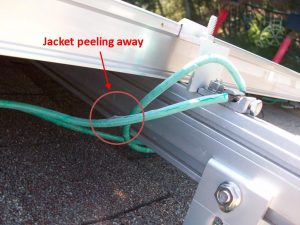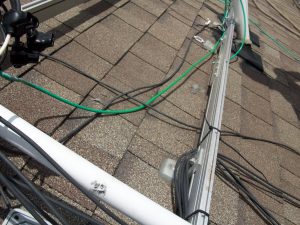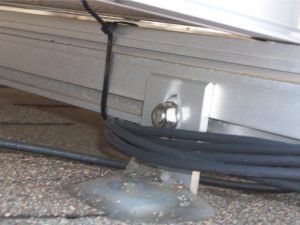(Second in a series about shady solar workmanship, how to tell the difference between a good and bad solar installation, and how to protect yourself from unethical or incompetent installers. Thanks to Jonathan Williams, my partner and VP of Installation & Service, for contributing stories “from the trenches” for this series.)
Most people think to ask about warranties on solar panels, but few ask about the inner workings of the system, such as the wiring. Out of sight, out of mind. But, if the wrong wire and/or wiring practices are used, your new system could need repair within a few years.
First off, the wiring on your roof- or ground-mounted system must be rated for outdoor use! Seems obvious, but we’ve seen indoor wire used with sad results. The wiring, even if tucked neatly out of sight, is exposed to heat, cold, rain, snow, wind, sleet, and all the wonderful natural elements that make living in New England such an adventure. The wiring must withstand those elements for 25+ years! Here’s an example of what one year of exposure does to the wrong wire.

This green ground wire is not rated to be outside without protection. The outside jacket has already started to peel away. Some people would say, “Oh it’s only the ground wire, you don’t need it for proper operation of the system” but they would be wrong. It is the most important wire in your entire solar system. It doesn’t have much to do with the system’s operation, but it’s what prevents YOU from being shocked if you touch an accidentally energized rail, panel frame or conduit.
So for your safety, make sure your installer uses the proper wire.
Second, wire management is an important aspect of a proper installation. When wiring is left dangling instead of secured properly, lots of things can become an issue. Unsecured wiring swings and sways with the wind. If the wires are resting on the roof like in this photo, it’s only a matter of time before the rough abrasiveness of your asphalt shingles wears through the insulating jacket on the wire, exposing the bare wire, which – it just so happens – is live whenever there is sun on the panels. (This is where the importance of the ground wire mentioned above comes in.)
If the wiring is in a tangled mess under the panels, you are more likely to have rodents making their homes under your panels. What’s the connection? The wires provide a lovely support structure upon which squirrels and chipmunks can build a nest of leaves and twigs.
If the critters aren’t interested in wintering in your wiring, Mother Nature jumps in. Leaves and sticks falling onto the roof and sliding or blowing under the panels will get caught in wiring that is not neatly secured. When winter rolls around, the accumulated brush will retain water and snow, allowing ice damns to build up. As New Englanders know, ice dams lead to roof leaks, and roof leaks aren’t usually covered by home insurance (or solar installer warranties) if caused by an “act of nature”. Never mind that the original culprit was poor installation practice.
Even wiring that looks neatly stored might be done wrong, like in this picture of wiring wrapped around an L-foot.

L-feet are cut from extruded aluminum. The manufacturing process does not include a de-burring step. This means the L-foot edges are razor-sharp – as Jonathan can attest, having cut himself on L-feet edges many times. What happens when wiring is wrapped around a razor-sharp edge? Obviously the edge will slowly cut through the insulation and expose the wire. It may take years, but it will happen.
Make sure your installer uses methods that will stand up to time, 10, 15, 50 years down the road.
Next week: Mounting Out of a Molehill
Didn’t see Part 1? Here it is.




